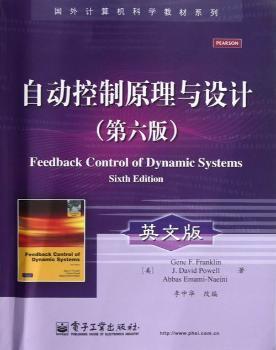内容简介
本书是自动控制领域的经典著作,以自动控制系统的分析和设计为主线,在回顾自动控制系统动态响应和反馈控制的基本特性基础上,重点介绍了自动控制系统的三种主流设计方法,即根轨迹设计法、频率响应设计法和状态空间设计法。此外,还阐述了非线性系统的分析与设计,给出了一系列经典控制系统设计实例。全书在阐述自动控制原理和设计方法的过程中,适时地穿插有MATLAB仿真源代码和仿真实验结果。
目录
1 An Overview and Brief History of Feedback Control
A Perspective on Feedback Control
Chapter Overview
1.1 A Simple Feedback System
1.2 A First Analysis of Feedback
1.3 A Brief History
1.4 An Overview of the Book
Problems
2 Dynamic Response
A Perspective on System Response
Chapter Overview
2.1 Review of Laplace Transforms
2.1.1 Response by Convolution
2.1.2 Transfer Functions and Frequency Response
2.1.3 The L Laplace Transform
2.1.4 Properties of Laplace Transforms
2.1.5 Inverse LaplaceTransform by Partial-Fraction Expansion
2.1.6 The Final Value Theorem
2.1.7 Using Laplace Transforms to Solve Problems
2.1.8 Poles and Zeros
2.1.9 Linear System Analysis Using MATLAB
2.2 System Modeling Diagrams
2.2.1 The Block Diagram
2.2.2 Block Diagram Reduction Using MATLAB
2.3 Effect of Pole Locations
2.4 Time-Domain Specifications
2.4.1 Rise Time
2.4.2 Overshoot and Peak Time
2.4.3 Settling Time
2.5 Effects of Zeros and Additional Poles
2.6 Stability
2.6.1 Bounded Input–Bounded Output Stability
2.6.2 Stability of LTI Systems
2.6.3 Routh’s Stability Criterion
2.7 Historical Perspective
Problems
3 A First Analysis of Feedback
A Perspective on the Analysis of Feedback
Chapter Overview
3.1 The Basic Equations of Control
3.1.1 Stability
3.1.2 Tracking
3.1.3 Regulation
3.1.4 Sensitivity
3.2 Control of Steady-State Error to Polynomial Inputs: SystemType
3.2.1 System Type for Tracking
3.2.2 System Type for Regulation and Disturbance Rejection
3.3 The Three-Term Controller: PID Control
3.3.1 Proportional Control (P)
3.3.2 Proportional Plus Integral Control (PI)
3.3.3 PID Control
3.3.4 Ziegler–Nichols Tuning of the PID Controller
3.4 Introduction to Digital Control
3.5 Historical Perspective
Problems
4 The Root-Locus Design Method
A Perspective on the Root-Locus Design Method
Chapter Overview
4.1 Root Locus of a Basic Feedback System
4.2 Guidelines for Determining a Root Locus
4.2.1 Rules for Plotting a Positive (180°) Root Locus
4.2.2 Summary of the Rules for Determining a Root Locus
4.2.3 Selecting the Parameter Value
4.3 Selected Illustrative Root Loci
4.4 Design Using Dynamic Compensation
4.4.1 Design Using Lead Compensation
4.4.2 Design Using Lag Compensation
4.4.3 Design Using Notch Compensation
4.4.4 Analog and Digital Implementations
4.5 A Design Example Using the Root Locus
4.6 Extensions of the Root-




 VIP会员
VIP会员